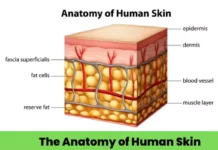Your skin is more than just a protective barrier; it’s a complex organ that plays a vital role in your overall health. At its core lies the dermis, often called the “true skin” by skincare professionals. This middle layer is where the real action happens, housing essential structures and functions that support skin vitality. Curious about what makes your dermis so crucial? Let’s explore its anatomy and functions to understand how it contributes to your skin’s well-being.
Understanding the Dermis: The Heart of Your Skin
The dermis is situated between the outer epidermis and the inner subcutaneous layer, acting as a bridge that connects your skin’s protective aspects with deeper tissues. While we often focus on the epidermis for its visible qualities, the dermis is where the magic happens, housing numerous essential components that ensure your skin remains healthy and resilient.
Key Structures of the Dermis
Within the dermis, you’ll find three main structural components that provide strength and elasticity: collagen, reticular fibers, and elastic fibers.
Together, these elements create a robust framework that not only protects but also maintains your skin’s youthful appearance.
Layers of the Dermis: A Closer Look
The dermis consists of two distinct layers: the papillary and the reticular layers.
In the papillary layer, which is closest to the epidermis, you’ll find loose connective tissue interspersed with tiny projections known as papillae. These papillae enhance your skin’s grip and contribute to unique fingerprint patterns. This layer is also rich in sensory receptors, such as Meissner’s corpuscles, which are sensitive to light touch and pressure.
The Reticular Layer: The Foundation of Strength
Beneath the papillary layer lies the reticular layer, characterized by dense connective tissue filled with collagen and elastic fibers. This network forms the backbone of the dermis, providing the structural support necessary for your skin to function effectively.
Here, you’ll also find various vital components, including blood vessels, sweat glands, hair follicles, and nerve endings, all working together to maintain skin health and functionality.
Biological Wonders of the Dermis
The dermis is not just a structural powerhouse; it also supports numerous physiological processes essential for skin health.
Blood vessels within the dermis deliver oxygen and nutrients, ensuring your skin remains nourished. Sebaceous glands produce sebum, which acts as a natural moisturizer, while sweat glands help regulate your body temperature. Furthermore, specialized cells like fibroblasts and glycosaminoglycans play crucial roles in tissue repair and immune defense.
Sensory Perception: The Dermis in Action
The dermis is key to your sensory experiences. It contains a rich network of nerves that transmit sensory information to your brain, allowing you to feel touch, pain, temperature, and pressure.
This intricate system enhances your interaction with the world around you, making the dermis a vital component of how you perceive your environment.
The Dermis: A Hub of Activity
In essence, the dermis orchestrates a range of essential functions that are crucial for skin health. From providing structural support to facilitating sensory perception, it plays a vital role in your skin’s overall performance.
Located just beneath the dermis is the subcutaneous fat layer, which offers additional cushioning and support, further enriching the skin’s functionality.
As we continue to explore the complexities of skincare, it’s essential to recognize the importance of nurturing this vital layer. By focusing on the health of the dermis, you can pave the way for radiant, youthful skin that endures the test of time.





















